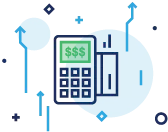
Chances are you’ve heard of a ‘recurring payment’ when it comes to a bill or a subscription account. However, there are many uses for recurring billing as a business owner. Recurring payments are simple and one of the most convenient ways for customers to pay for a good or service. They’re also beneficial for businesses that offer this type of payment. Recurring billing can provide a variety of benefits, including customer retention, speedy and on-time payments, and lower collection costs. Additionally, offering recurring payments may appeal to your customers because it’s one less bill to manage every month.
If your business has weathered the storm of the pandemic and uncertainty of the economy, recurring revenue is a welcome trend. In fact, recurring billing is projected to be a major growth step for rebuilding businesses in the coming year.
What Is a Recurring Payment?
A recurring payment is a transaction that charges a customer’s bank account on a recurring basis. The most common example is an automatic monthly payment made in exchange for services. Recurring billing is widespread through a variety of industries. Examples include subscriptions, utility auto payments, and gym memberships.
These days, most online businesses offer a recurring billing option. It’s one of the most convenient ways businesses and their consumers make regularly scheduled payments.
How do Recurring Payments Work?
Similar to how an eCheck works, a recurring payment is all electronic. However, instead of using an account and routing number like traditional checks, a customer gives you their credit card information. You make an agreement and the client authorizes the transaction and frequency. Then, through the use of a payment gateway, the payments come from their credit or bank account on the same date every period.
When customers choose to sign up for recurring payments, they will accept your terms and conditions for credit card processing. They accept the amount charged, the frequency of which the payment will be deducted, and when the billing ends. According to consumer statistics, most consumers prefer monthly payments. Once the terms and conditions are agreed upon, the customer will provide you with their payment information via secure software. From there, the payment processor will reach out to the customer’s bank or credit card company to approve the transaction. Upon approval, the funds are deposited into the merchant’s account.
Recurring Payment and the Subscription Industry
The subscription industry is growing in popularity. From tea boxes and meal kits to clothing and magazine subscriptions, there’s a subscription for everything. Most of these subscription services set up recurring billing until the client chooses to cancel or skip their monthly order. In fact, some say subscriptions are the exact definition of a recurring payment. Subscriptions give clients the option to set up payments without having to worry about another monthly bill to manage.
What are the Benefits of Recurring Billing?
Thanks to the simplicity of recurring payments, all the work is taken out of the billing process. You still need a billing department to reach out to customers if their payment is declined. However, the rest falls into the terms and conditions agreed upon with the first transaction. Because of this, recurring billing offers customers the convenience of never worrying about paying another bill on time. Not only that, but it also provides businesses with several benefits other payment options do not.
Speedier payments

The time it takes for a customer to decide to pay you is no longer an issue for organizations. When a customer sets up recurring billing, they don’t have as much time to leave the transaction up to the payment software. This means you’re more likely to receive payment faster and on time. As time goes on, you can start to count on this income in your business’ financial planning and use it to focus sales efforts on getting new customers.
Convenience
Instead of businesses and customers making the same charge over and over by manual entry, the payment information can be stored in a database that charges the customer’s account regularly. This is known as negative option billing. There are different options available to make recurring payments as simple as possible. Some merchants may decide to only allow checking account and routing numbers, while others choose to accept credit card payments.
An example of convenience
If you’ve heard of the online pet store Chewy and used it to purchase items for your pet, you may have seen the option for recurring deliveries. This lets customers store their payment information online and set up a delivery date for the goods they’re expecting. Customers can choose different frequencies of online payment, depending on how often they want to receive the product. This gives the customer a hassle-free experience of shopping for their pet’s needs by allowing the payment to come from their account each month. In fact, pet subscription services are on the rise as providers take advantage of recurring billing.
Account updater
Account updater is an integratable feature by Authorize.net that automatically updates credit card information once a month. If a card is re-issued, Visa will retrieve the new number and update the customer’s recurring billing account for a small fee. This feature prevents you from experiencing any payment interruptions, risking cancellation, or having to track down customers. You’re only charged per update, so if you don’t use the service you will not pay the fee. Automatic updates save your business time, and the benefits far outweigh the costs in the long run.
More transparent budgeting
Recurring billing makes budgeting easy for your business. When you set up recurring payments with your clients, you are cutting back on the cost of paper billing and you can know what your business should expect in revenue each month from your existing customers. If budgeting is difficult for your business, recurring billing will make it much simpler.
Customer retention
When a customer has set up recurring payments, it’s often tricky for them to go in and cancel the subscription and easier to just make regular payments. It also increases customer satisfaction because the convenience of recurring payment is easier than going on to a website to make a payment every month. This will keep your customers happy with your business and prevent churn.
How to Set Up Recurring Payments

There are several ways to set up recurring payments. First, meet with your merchant services provider to see what kind of options they offer. Once you know what they require, how to set it up, and the rates you should expect, the merchant services provider will then grant access to a payment processor. The processor securely stores the customer’s payment information and successfully pulls payments on the same date of every month. Some businesses utilize payment reminder emails to help clients remember to pay you, either before or after the money is owed.
Continuity or subscription businesses are considered high risk in the payment processing world and may require a specialized merchant services provider. If you fall into this category, ensure you’re partnering with a company that can accommodate you properly.
Final Thoughts
If you’re considering recurring billing for your business, it’s important to consider what type of industry your organization falls into and whether recurring payments would be beneficial to you. Fortunately, this payment method is convenient and simple for businesses and customers alike. Recurring payments are easy to set up by reaching out to your merchant services provider and setting your account up with everything you’ll need.






